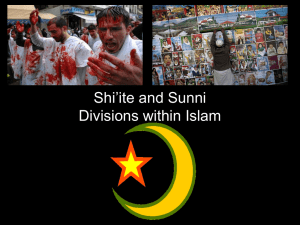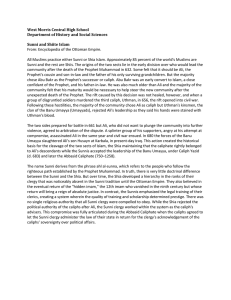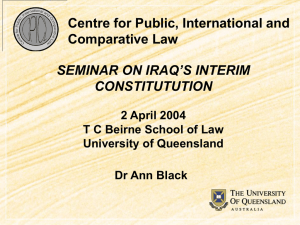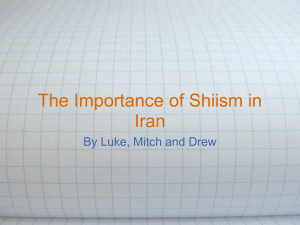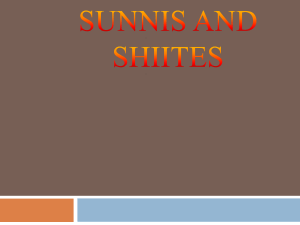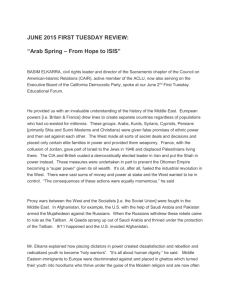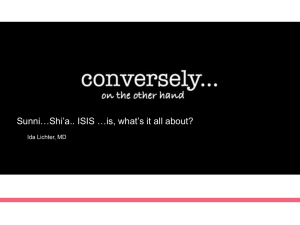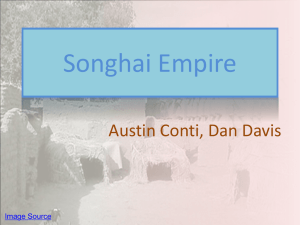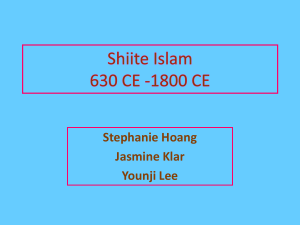Conflicts between Sunni and Shia Muslims
advertisement
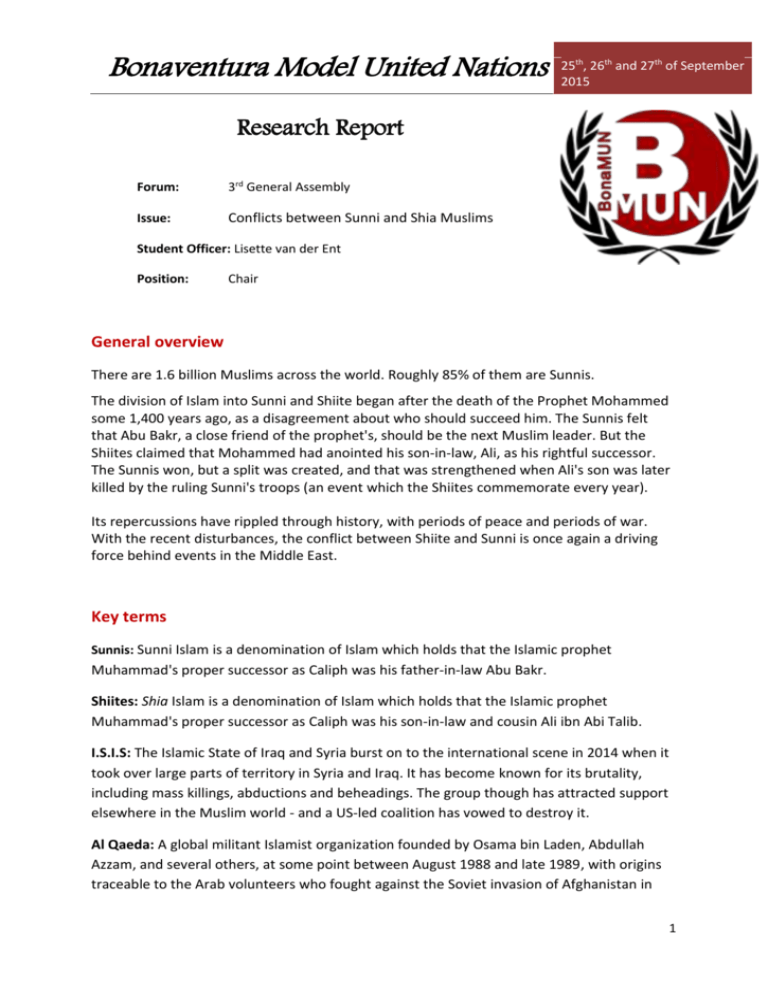
Bonaventura Model United Nations 25th, 26th and 27th of September 2015 Research Report Forum: 3rd General Assembly Issue: Conflicts between Sunni and Shia Muslims Student Officer: Lisette van der Ent Position: Chair General overview There are 1.6 billion Muslims across the world. Roughly 85% of them are Sunnis. The division of Islam into Sunni and Shiite began after the death of the Prophet Mohammed some 1,400 years ago, as a disagreement about who should succeed him. The Sunnis felt that Abu Bakr, a close friend of the prophet's, should be the next Muslim leader. But the Shiites claimed that Mohammed had anointed his son-in-law, Ali, as his rightful successor. The Sunnis won, but a split was created, and that was strengthened when Ali's son was later killed by the ruling Sunni's troops (an event which the Shiites commemorate every year). Its repercussions have rippled through history, with periods of peace and periods of war. With the recent disturbances, the conflict between Shiite and Sunni is once again a driving force behind events in the Middle East. Key terms Sunnis: Sunni Islam is a denomination of Islam which holds that the Islamic prophet Muhammad's proper successor as Caliph was his father-in-law Abu Bakr. Shiites: Shia Islam is a denomination of Islam which holds that the Islamic prophet Muhammad's proper successor as Caliph was his son-in-law and cousin Ali ibn Abi Talib. I.S.I.S: The Islamic State of Iraq and Syria burst on to the international scene in 2014 when it took over large parts of territory in Syria and Iraq. It has become known for its brutality, including mass killings, abductions and beheadings. The group though has attracted support elsewhere in the Muslim world - and a US-led coalition has vowed to destroy it. Al Qaeda: A global militant Islamist organization founded by Osama bin Laden, Abdullah Azzam, and several others, at some point between August 1988 and late 1989, with origins traceable to the Arab volunteers who fought against the Soviet invasion of Afghanistan in 1 Bonaventura Model United Nations 25th, 26th and 27th of September 2015 the 1980s. It operates as a network consisting of both a multinational, stateless army, and an Islamist, extremist, Wahhabi, jihadist group. It has been designated as a terrorist group by the United Nations Security Council, the North Atlantic Treaty Organization (NATO), the European Union, the United States, Russia, India, and various other countries. Al-Qaeda has carried out many attacks on targets it considers kafir (an unbeliever). Timeline (Taken and modified from http://www.npr.org/2007/02/12/7280905/chronology-a-history-of-the- shia-sunni-split) 570: The Prophet Muhammad is born. 632: Muhammad dies. Abu Bakr is chosen as caliph, his successor. A minority favors Ali. They become known as Shiat Ali, or the partisans of Ali. 656: Ali becomes the fourth caliph after his predecessor is assassinated. Some among the Muslims rebel against him. 661: Violence and turmoil spread among the Muslims; Ali is assassinated. 680: Hussein, son of Ali, marches against the superior army of the caliph at Karbala in Iraq. He is defeated, his army massacred, and he is beheaded. The split between Shiites and Sunnis deepens. Shiites consider Ali their first imam, Hussein the third. 1920-1922: Arabs, both Shiite and Sunni, revolt against British control of Iraq. 1932: Iraq becomes an independent nation, under King Faisal, a Sunni Arab. 1935: Persia is renamed Iran. 1941: Reza Shah abdicates throne in favor of his son Mohammad Reza Shah. British and Soviet military forces occupy Iran. 1953: A joint CIA/British intelligence operation in Iran keeps the shah on the throne and ousts nationalist Prime Minister Mohammad Mossadegh. 1979: Saddam Hussein seizes power, becomes president of Iraq. Iranian revolutionary students seize the U.S. Embassy in Tehran and take diplomats hostage. They are released in January 1981. 1980: Saddam orders the Iraqi army to attack Iran. 2 Bonaventura Model United Nations 25th, 26th and 27th of September 2015 1980-1988: Iran-Iraq War. Hundreds of thousands die on each side and the war ends in a stalemate. 1982: Israel invades Lebanon, seizes Beirut. Hezbollah is formed in Lebanon. 1983: Suicide truck bombers, believed to be Hezbollah, kill 241 American servicemen in Beirut. 1990: Saddam orders his army to seize Kuwait. 1991: The U.S. military ousts the Iraqi army from Kuwait. Shiites of southern Iraq rebel against Saddam, who puts down the rebellion brutally. Thousands of Shiites are killed. 1991-2003: Iraq is placed under economic sanctions. U.N. weapons inspectors destroy most of Iraq's nuclear, biological and chemical weapons programs. 2001: Al-Qaida, led by Sunni Muslim fundamentalists, mounts attacks in the United States, killing 3,000 people. The United States invades Afghanistan and ousts the Sunni Taliban government. 2003: The U.S. military invades Iraq, topples Saddam. An Iraqi insurgency erupts, led by Sunni Baathists and al-Qaida. 2005-2006: Iraqi elections bring Shiite political parties to power in Baghdad, backed by Iran. Sunni-Shiite sectarian violence intensifies. 2005: Hard-line fundamentalist Mahmoud Ahmadinejad is elected president in Iran. Iran pursues acquisition of nuclear technology. 2006: War breaks out between Israel and Hezbollah in Lebanon. The U.N. Security Council imposes economic sanctions on Iran in response to nuclear activities. 2007: The United States sends additional troops to Iraq. Possible Solutions 1. Muslim governments, whether Sunni or Shia, should respect the rights of their citizens irrespective of their religious beliefs. So the Sunni majority countries should treat their Shia citizens as equal, and the Shia majority countries should do the same thing regarding their Sunni minorities. 2. Muslim countries should stop using religion as an instrument of security and foreign policy, and instead focus on practical ways of resolving conflicts and building viable institutions for conflict prevention and promotion of peaceful relations. 3 Bonaventura Model United Nations 25th, 26th and 27th of September 2015 3. The great powers should not manipulate sectarian divisions in the pursuit of their interests. As history bears witness, any short–term gain tends to be accompanied by long–term trouble and loss. Bibliography http://www.bbc.com/news/world-middle-east-16047709 https://www.google.nl/#q=Conflicts+between+Sunni+and+Shia+Muslims http://www.un.org/apps/news/story.asp?NewsID=46909#.VfcrU8uUfIU http://www.theguardian.com/world/2015/apr/05/sunni-shia-why-conflict-more-political-thanreligious-sectarian-middle-east http://www.cfr.org/peace-conflict-and-human-rights/sunni-shia-divide/p33176#!/ https://en.wikipedia.org/wiki/Shia%E2%80%93Sunni_relations http://www.bbc.com/news/world-middle-east-29052144 http://www.npr.org/2007/02/12/7280905/chronology-a-history-of-the-shia-sunni-split http://thediplomat.com/2014/05/solving-the-sunni-shia-conflict-begins-with-tehran/ https://acmcu.georgetown.edu/sunni-shia-tensions (All information was taken and edited from the sites above) If you want some quick information, watch this video: https://www.youtube.com/watch?v=5KLvjs7Yrtw 4
